
Did you know that laser lipo, also known as laser liposuction, has become one of the most popular cosmetic procedures in the United States, with over 270,000 procedures performed in 2020 alone?
If you're considering this minimally invasive fat removal technique, understanding the recovery timeline and essential tips can be crucial to achieving optimal results.
From immediate post-procedure care to long-term maintenance, navigating the stages of laser lipo recovery can significantly impact your overall experience and satisfaction with the procedure.
Immediate Recovery
After undergoing laser lipo, you may experience some immediate discomfort and swelling at the treatment site, which is normal and should subside within a few days. To manage the pain, over-the-counter pain relievers such as acetaminophen or ibuprofen can be taken as directed. Additionally, applying ice packs to the treated area for 15-20 minutes at a time can help reduce swelling and discomfort.
It's important to avoid any strenuous activity immediately after the procedure. Resting and allowing your body time to heal is crucial for a smooth recovery. While it's essential to avoid vigorous exercise, light walking is encouraged to promote blood circulation and aid in the healing process.
Keep an eye out for any signs of infection, such as increasing redness, swelling, or pain at the treatment site, and contact your healthcare provider if you notice any concerning symptoms.
First Week Post-Procedure
If you've successfully managed your pain and monitored your activity level during the immediate recovery period, the first week post-procedure is a crucial time for continued rest and care to support your body's healing process. Pain management remains a priority during this phase. It's normal to experience some discomfort, swelling, and bruising, but if you notice any unusual or severe pain, contact your healthcare provider immediately. Follow the prescribed pain medication regimen and use ice packs as directed to alleviate swelling and discomfort.
Additionally, continue to be mindful of your activity level. While you may start to feel more energetic, it's essential to avoid strenuous activities and heavy lifting during the first week. Light walking is encouraged to promote circulation and prevent blood clots, but listen to your body and avoid any activity that causes pain or discomfort. Remember to wear any compression garments as instructed to support the healing process.
Nutrition and hydration are also crucial during this phase. Focus on consuming a healthy, balanced diet and staying well-hydrated to aid in your body's recovery. By prioritizing pain management, monitoring your activity level, and maintaining a healthy lifestyle, you can support your body's healing process during the first week post-procedure.
Weeks 2-4: Healing Progress
As you progress into weeks 2-4 post-procedure, you can expect to see continued improvement in your healing process. It's important to monitor your healing milestones and continue to practice scar management to ensure the best possible outcome. Here's a guide to help you track your healing progress during this time:
| Healing Milestones | Week 2 | Week 3 | Week 4 |
|---|---|---|---|
| Reduced Swelling | ✓ | ✓ | ✓ |
| Decreased Bruising | ✓ | ✓ | ✓ |
| Improved Mobility | ✓ | ✓ | ✓ |
During weeks 2-4, you should start to notice reduced swelling and decreased bruising. Your mobility will continue to improve, allowing you to resume light activities as your body heals. It's essential to follow your healthcare provider's advice on scar management. This may include keeping the incision sites clean, applying recommended ointments, and protecting the area from sun exposure to promote optimal healing. By staying mindful of these healing milestones and following scar management protocols, you can support your body's recovery and achieve the best possible results.
Month 2: Results and Restrictions
Continuing into month 2 post-procedure, you'll notice the emergence of significant results and the need to adhere to certain restrictions to ensure continued progress in your healing journey.
- Results Assessment: At this stage, it's important to assess the results of the laser lipo procedure. You may notice a significant reduction in the targeted areas, with improved contours and a more sculpted appearance. Take the time to appreciate the progress and celebrate the positive changes in your body.
- Activity Modifications: While you may be eager to resume your regular exercise routine, it's crucial to follow the activity restrictions provided by your healthcare provider. Engaging in high-impact or strenuous activities too soon can compromise the healing process and affect the final results. Focus on low-impact exercises and gradually reintroduce more intense workouts as advised by your medical team.
- Patience and Self-Care: As you witness the transformation taking place, it's essential to practice patience and prioritize self-care. Embrace a healthy lifestyle, maintain a balanced diet, and stay hydrated to support your body in achieving optimal results. Additionally, continue to follow post-procedure care instructions diligently to ensure the best possible outcome.
Long-Term Recovery and Maintenance
To maintain your results and support long-term recovery after laser lipo, it is crucial to adhere to a consistent exercise regimen and a balanced diet. Long-term maintenance involves making lifestyle changes that prioritize your overall health and well-being. Follow-up care plays a significant role in ensuring the longevity of your results. It is essential to stay connected with your healthcare provider and attend all scheduled follow-up appointments to monitor your progress and address any concerns that may arise.
In terms of diet recommendations, focus on incorporating whole foods such as lean proteins, fruits, vegetables, and whole grains into your meals. Avoid processed foods, excessive sugar, and unhealthy fats. Drinking an adequate amount of water and avoiding sugary beverages can also support your long-term recovery and maintenance.
Consider the following tips to support your long-term recovery and maintenance:
| Exercise | Diet |
|---|---|
| Incorporate a variety of exercises such as cardio, strength training, and flexibility exercises into your routine. Aim for at least 150 minutes of moderate-intensity aerobic activity per week. | Consume a well-balanced diet that includes a variety of nutrients. Limit your intake of processed foods and sugary snacks. Incorporate plenty of fruits, vegetables, and lean proteins into your meals. |
Frequently Asked Questions
Can I Resume My Regular Exercise Routine Immediately After Laser Lipo?
You shouldn't resume your regular exercise routine immediately after laser lipo. It's important to follow the exercise restrictions provided by your doctor to ensure proper healing.
The recovery timeline for laser lipo varies, but typically, you'll need to wait a few weeks before gradually reintroducing exercise. Prioritize rest and follow your doctor's guidelines for a healthy recovery.
How Soon Can I Expect to See Noticeable Results After the Procedure?
You should start to see noticeable results from laser lipo within a few weeks.
Typically, you can expect initial results within 1-2 weeks, but final results may take a few months as your body fully heals and adjusts.
It's important to follow the recovery timeline provided by your doctor to ensure the best possible outcome.
Be patient and consistent with your post-procedure care for the best results.
Are There Any Specific Dietary Restrictions I Should Follow During the Recovery Period?
During your recovery period, it's important to follow specific dietary guidelines to support healing and optimize results.
Eating a balanced diet with plenty of fruits, vegetables, lean proteins, and whole grains can help with the recovery timeline.
It's also important to stay hydrated and avoid excessive alcohol and processed foods.
Following these dietary restrictions can aid in a smoother recovery and enhance the benefits of your laser lipo procedure.
What Can I Do to Minimize Scarring or Any Potential Complications After Laser Lipo?
To minimize scarring and prevent complications after laser lipo, it's crucial to follow post-operative instructions carefully. Keep the treated area clean and dry, as directed by your surgeon. Avoid strenuous activities and follow the recommended recovery timeline.
Attend all follow-up appointments to ensure proper healing and address any concerns promptly. Additionally, protect the incision sites from sun exposure and consider using scar-minimizing creams or silicone sheets as advised by your medical team.
Are There Any Potential Long-Term Effects or Risks Associated With Laser Lipo That I Should Be Aware Of?
You should be aware of potential long-term risks associated with laser lipo. Long-term effects may include scarring, skin irregularities, and changes in sensation. By following post-op instructions and maintaining a healthy lifestyle, you can reduce these risks. It's important to follow recovery tips to minimize these risks. Keep an eye out for any unusual symptoms and consult your doctor if you have any concerns about your recovery.
Conclusion
Overall, laser lipo recovery takes time and patience, but following the recommended timeline and tips can help you achieve the best results.
It's important to follow your doctor's instructions closely, especially during the immediate recovery and first few weeks post-procedure.
Remember to take it easy, allow your body to heal, and maintain a healthy lifestyle to ensure long-term success with your laser lipo results.




© All Copyrights 2023-2024 by Utah Lipo & Body Sculpting









